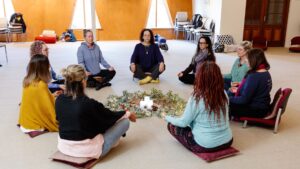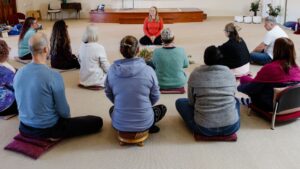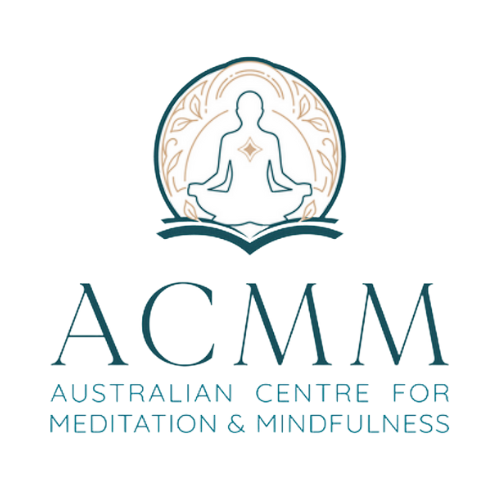Would you like to share meditation with your community, clients, co-workers, friends or family? Learn how to lead a meditation session with confidence!
Here are some foundational tips to give you clarity in crafting a supportive and nurturing meditation session and leading with confidence from Lisa Forde, founder of the Australian Centre for Meditation and Mindfulness. Australia’s leading meditation teacher training college.
Tip Number 1 – Create a welcoming space
Think about soft lighting, colours, textures and warmth. On your intake form, you may like to ask your students if they prefer music on or off. If on, then ensure that you have a music track that will last the distance with you, or that you can loop to ensure that sound doesn’t suddenly cut off. Spotify is great as you can create a playlist that works for a particular session or group. The meditation session begins the moment people walk into the room, and ideally, you want people to feel welcome and comfortable. If practical, you may like to have tea available and show them where the amenities are.

Tip Number 2 – Think carefully about seating
A good portion of your students may not be able to sit on the floor, or may not be comfortable sitting on a yoga mat. So, provide a range of seating options including lying with a blanket (if appropriate), cushions and chairs. Some people will need back support, so if you’re able to offer bolsters or places against a wall, do so.
Placing people in a circle can be a way of ensuring that you can see everyone, and that there is a sense of equality and togetherness. A circle is a shape seen in nature and is a symbol of unity and wholeness.
Tip Number 3 – Have a session plan
Even if it’s a brief outline, know how your session is going to run. You might start by introducing yourself and letting people know what is going to happen in the session. You might like to create some group agreements around confidentiality or what to do if students need to stand or move, or fall asleep during the meditation. Create a group agreement together so that students are more likely to stick to the agreement and feel heard and appreciated.
You might like to offer permission to the group to do what is right for them during the meditation, even if it’s different to your guidance. That way people feel like they are the master of their own experience. It can help to let people know that there is no right experience to have and that all experiences are welcome and ok. Even and especially if they don’t feel calm or serene after the practice.
After you have guided the meditation or taught and demonstrated the practice, offer some time for discussion and questions. Depending on the kind of group you are running, you may have a ritual or statement to begin and end the session.
Tip Number 4 – Introduce or explain the technique

If you know the technique you plan to use beforehand, then give some background to the students. You might like to explain the origins of the technique, and how you came across it. Perhaps there are variations to the technique that might be useful for the students to know before beginning. It’s important to reiterate that there are no desired outcomes and that everyone’s experience is okay so that students don’t place pressure on themselves, which goes against the nature of meditation. You might like to offer a way for students to let you know if they are struggling by raising their hand, or something else. Gentle movement during meditation should also be allowed.
You might also like to share some information about thoughts, and our relationship with them. Most people think that they are supposed to stop thinking in meditation, which of course, is not the case and can be a challenge for everyone.
Give students the opportunity to ask any questions before they begin.
Tip Number 5 – The meditation experience
If you are an ACMM graduate meditation teacher, then you will be confident guiding a trauma-sensitive meditation or mindfulness practice of any length without a script. If you do feel the need to use a script, keep it to an outline only, and colour it in with your own words and concepts. One reason why guiding meditation without a script works best is that you can be lightly meditating yourself at the same time as guiding. This will ensure that you deliver the best possible experience to your group and that you can lead with a relaxed, gentle tone in your voice. You will also more readily be able to offer appropriate pauses and silences where needed. Being there, in the meditation with your group is definitely the best way to guide, if possible.
Make sure that once you have set the scene with your guidance, you then offer plenty of silent time, for students to practice on their own.
Once the meditation experience is complete and you have guided students’ awareness back to the group space, allow some time for people to adjust their eyes, thoughts and feelings before beginning a discussion. Avoid direct eye contact for a few minutes until your students look ready to share.
Tip Number 6 – The sharing space
There can be a lot of variation between and within groups around how comfortable people feel sharing their experiences in a group. In order to promote sharing in a respectful and gentle way, you might like to make sharing optional. Perhaps provide people with the opportunity to share in pairs before sharing back to the group. Ask people to write their thoughts in a journal and then share what they feel comfortable sharing to the group. In the ACMM Training, meditation and mindfulness teachers learn appropriate listening and facilitation skills to help students feel heard and supported, and handle challenges.
The longer a group has been together, the more open the sharing generally becomes. Be patient whilst people get to know each other. For some, entering their inner world, and sharing their experiences with others can feel very new and foreign. It may take time to build this new skill.

Tip Number 7 – Handling challenges and contraindications
One of the reasons why completing a reputable Meditation Teacher Training Course is so important, is so that you will be well equipped to handle the unexpected in your group. From time to time, some students may feel emotional, experience increased sensitivity or other disturbances, and your guidance, reassurance and advice will be essential. It is also very important to have a list of practitioners (preferably people that you can personally recommend from your own experience), that you can refer your students to, should they require further support. A psychologist, psychotherapist, counsellor, psychiatrist or other mental health professionals should be on the list. Ideally, it’s good to be able to give students a few options rather than just one.
Tip Number 8 – Closing your meditation session, group or class
Once you have addressed any questions, and students have had a chance to share, you might like to let people know what to expect at the next class. This may help with attendance rates, as students may look forward to the topic or practice. Alternatively, you may like to ask your students if they have requests.
I like to end a group by giving people the opportunity to say how they are feeling right now. You may like to thank your group and make any other announcements. Make sure everyone looks alert and ready to travel home. If not, you might like to suggest people have a drink, and move their bodies to wake themselves up, or depending on the circumstances, go for a walk before driving.
If you appear relaxed and comfortable, smile and look like you are enjoying the session and leading the group, then the likelihood is that your students will enjoy it too. Many ACMM graduates tell me that they can’t believe they are being paid to do this work. It’s such a joy!
To be able to provide an excellent meditation or mindfulness session, and to do so with full accreditation, insurance and professional registration is an important responsibility. See below for Meditation Teacher Training Options at ACMM.
Author Lisa Forde
Together, we’re building a brighter future for meditation and mindfulness teaching in Australia. Let’s continue to support one another and celebrate our shared journey as meditation teachers!
At ACMM, you will discover a world of online and accredited meditation and mindfulness teacher training. We offer Certificate, Advanced Certificate, and Diploma Training Options, with optional Business Development Support alongside and after your training.
Find out if our courses are the right fit for you. Book a Zoom Discovery Call with us today!





